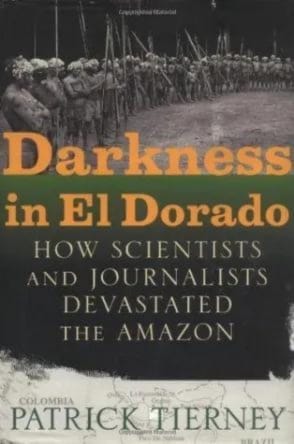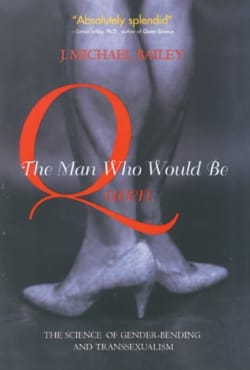Activism
From South American Anthropology to Gender-Crit Cancel Culture: My Strange Feminist Journey
Anthropology taught me how to spot this instinct. Gender-critical feminists taught me how to stand up to it.

I’m one of the many academics who’ve been “canceled” for having the wrong sort of opinion—or quasi-canceled, at least. As of this writing, I remain an associate professor of Anthropology at the University of Alberta. Since July 2019, I had also served as the department’s undergraduate programs chair. It was supposed to be a three-year appointment. But in late March, I was dismissed from that position due to informal student complaints to the effect that I had made them feel “unsafe” by articulating feminist critiques of current theories of gender. Earlier this month, my colleague Carolyn Sale wrote up an account of my case for the Centre for Free Expression blog at Ryerson University. As tends to be the case with these controversies, this in turn caused students and colleagues to scour my social media accounts in search of yet more “gender-critical” commentary. When they found it, they demanded that I be fired from my tenured position and charged with hate speech.
Articles of the type you are now reading typically channel great anger, resentment, or sorrow. But in my case, I have to acknowledge that, a decade ago, it’s likely that I would have added my voice to the clamor to put a head like mine (the 2020 version of it) on a metaphorical pike. To my shame, in fact, I’m pretty sure I once joined the campaign to cancel Canadian sexologist Kenneth Zucker after reading an article about his cautious approach in regard to “affirming” the gender dysphoric claims of children. (Zucker’s work had been wrongly denounced as “conversion therapy,” and he later won an apology and large cash settlement from his employer, the Toronto-based Centre for Addiction and Mental Health, which had echoed the false claims against him in a public review of his work.)
In any event, I would like to tell the story of how I got from there to here—because I am hardly the only feminist who’s walked away from the beliefs and postures associated with radicalized trans activism. There will be many more of us coming forward in the years to come. And so it might be useful for readers to understand how one of us became invested in the debate surrounding gender ideology, and subsequently became disillusioned.
* * *

I first became attuned to the subject indirectly, through reading Alice Dreger’s coverage of an unrelated controversy in anthropology. At this point, I should note that I’d trained as a lowland South Americanist anthropologist under the supervision of Dr. Manuela Carneiro da Cunha and Dr. Terence Turner at the University of Chicago during the late 1990s and early 2000s. Dreger, a historian and bioethicist who would begin teaching at Northwestern University in nearby Evanston in 2005, was scathing about Dr. Turner’s involvement in urging the American Anthropological Association to investigate dramatic allegations regarding anthropologist Napoleon Chagnon and geneticist James Neel, especially their work among the Yanomami Indigenous people of Venezuela.
This was a huge scandal in anthropological circles at the time, originating in a 2000 book by journalist Patrick Tierney, Darkness in El Dorado: How Scientists and Journalists Devastated the Amazon. An American Anthropological Association investigation eventually concluded that several of Tierney’s most dramatic allegations could not be substantiated. But I was skeptical of Dreger’s claims to have made a comprehensive and dispassionate analysis of the case. From what I could tell, she’d never spoken to a single Yanomami person in the course of her inquiries, nor bothered to investigate earlier challenges to Dr. Chagnon’s ethics made by the Brazilian Anthropological Association. Moreover, the portrait of Professor Turner she presented seemed to misrepresent his conduct, motivations, and scholarship.
In 2010, I was invited to participate in a roundtable at the American Anthropological Association meetings, entitled “The Yanomami Controversy, A Decade Later.” I decided to discuss Dreger’s handling of the Yanomami controversy in light of her earlier analysis of the ferocious backlash surrounding sexologist J. Michael Bailey’s 2003 book about trans-identified men, The Man Who Would Be Queen: The Science of Gender-Bending and Transsexualism. In both instances, I contended, Dreger mounted a defence of a besieged male academic whose research ethics had come under serious scrutiny. Moreover, both Bailey’s and Chagnon’s theoretical frameworks drew upon principles of evolutionary psychology to which I objected on feminist intellectual grounds. I prepared a paper on the subject entitled ‘Alice Dreger and the Academic Retrosexuals‘, and eventually contacted Andrea James, a trans-identified man who came in for particular opprobrium in Dreger’s work.
Andrea—whom I found friendly, informative, and funny—put me in touch with other trans activists, and gave me helpful commentary on successive drafts of my paper. Eventually, the paper got an encouraging revise-and-resubmit response from a good anthropology journal. But one of the reviewers urged me to rehash the entire El Dorado controversy within the limited space available. Since I preferred to focus on my feminist take on the parallels between the two cases, I withdrew the paper from consideration and decided to rewrite it entirely, this time for a gender-studies journal.

This was in the early 2010s. (I was getting divorced and raising a toddler on my own at the time, so I will confess that my memory of the chronology is somewhat fuzzy.) At this juncture, I’d written only for the anthropological literature, and so was naïve about the state of play on gender issues. I had an inkling that there wasn’t a unified feminist position on trans issues; and that some feminists, such as Janice Raymond, author of The Transsexual Empire: The Making of the She-Male, had expressed hostility to the idea of “transsexuals” (as was then a commonly used term) back in the late 1970s. But my impression was that Raymond had been part of the feminist second wave, which I’d thought no one bothered with anymore. Just to ground my arguments, however, I figured I’d do a bit of a research to make sure my approximate sense of the state of the feminist literature on trans issues was adequate.
I remember coming across a website called Gender Trender, maintained by a pseudonymous lesbian radical feminist named Gallus Mag. At first, I perused it as an anachronistic curiosity—an odd outpost from a bygone feminist era, atavistically hostile to the more up-to-date proposition that trans women are women. But Gallus’s prose style was funny and straightforward, in contrast to most gender-studies academic writing, and I found myself drawn back again and again to see what the old dinosaur (as I imagined her to be) would say next.

But for all Gallus’s sardonic manner of presentation, I came to realize the information she was documenting on her site was quite serious. She covered, among other things, the 2016 murder of two lesbians and their son in East Oakland, a crime for which prosecutors charged a trans-identified man named Dana Rivers (who’d also been an organizer of the “Camp Trans” campaign against a women-only music festival called Michfest during the 1990s). Gallus wasn’t paranoid in describing “female erasure” and “lesbian erasure”; nor in her insistence that gender ideology—which includes the belief that men may become women, and vice versa, by an act of declaration—served male interests.
I also began to appreciate her claim that the mainstream media often was reluctant to report on any facts that cast doubt on orthodox gender ideology. That aforementioned 2016 triple murder, strangely, received little media coverage. And Gallus’s own blog, which had been subject to countless attacks by trans activists, was censored and then taken down by WordPress in 2018 when she broke the story of Jonathan Yaniv—an eccentric Canadian misogynist who’s managed to deplatform dozens of women who express disgust at his aggressive sexual prurience (or who refuse to call him “Jessica”). But by this time, I was also reading Meghan Murphy’s Vancouver-based blog Feminist Current. (Infamously, Murphy herself was tossed off Twitter due to her interactions with Yaniv.) We are only now getting to the point where mainstream outlets, such as the Times of London and Newsweek, are giving air time to the gender-critical side.

A full decade has passed since I began paying sustained attention to trans activism and gender ideology. I have published an essay of my own at Feminist Current, become an active commenter on the feminist social networking site Spinster, signed the Women’s Declaration on Sex-Based Human Rights, and become one of two Canadian country contacts for its campaign. In the process, I’ve met inspiring feminists from all around the world who share my concerns, and who are fighting rollouts of eerily identical gender-identity laws in diverse national contexts.
And yet I have never finished re-writing that El Dorado/Man Who Would be Queen paper that started it all—because the kind of feminist analysis I’d originally designed it around is no longer persuasive to me.
As I’ve changed, so has the world around me. In 2017, Canada became governed by Bill C-16, which adds “gender identity or expression” to the list of prohibited grounds of discrimination contained in the Canadian Human Rights Act. During the 2019–2020 academic year, the University of Alberta, my employer, brought in a sweeping set of policies aimed at promoting “equity, diversity, and inclusion” (EDI) in the workplace, complete with the obligatory focus on gender at the expense of sex. All of this has arisen at a university that, during my 15 years here, has otherwise provided me with an agreeable and supportive environment. By and large, I’ve been happy at the University of Alberta, and I’m sorry to come into conflict with it.
The conflict, though, is unavoidable. Contemporary gender ideology requires active affirmation of the proposition that men can become women and that women can become men. It further asserts that to refuse to assent to this proposition is to do active “harm” to trans-identified individuals. The doctrine requires uncritical reverence for retrograde gender constructs, such as the idea that a little boy who likes tea parties and pretty dresses can be deemed to have been “born in the wrong body” (and so is actually, in fact, a little girl).
I’m not on Facebook, but I regularly hear from friends that I’ve been charged on this or that Facebook page with “denying the existence of trans people.” My detractors may well be correct that I am in violation of my employer’s EDI policies by insistently bringing up biology, and by engaging in the critique (and sometimes mockery) of gender identity claims. This is my form of political dissent. And I cannot avoid getting into trouble, because I now know things I did not know 10 years ago.
Whatever the initial aims of gender-ideology advocates, this system of beliefs is leading to real horrors being inflicted upon women and children. Activist Heather Mason, for instance, has documented the harassment and abuses that have predictably resulted from transferring purportedly trans-identified men to women’s prisons. In 2005, the year I moved to Edmonton from the United States, a 13-year-old girl named Nina Courtepatte was raped, beaten to death with a hammer, and set on fire on an Edmonton golf course. Her killer now claims to identify as a woman and is housed with female inmates. Is anyone concerned about their right to “safe spaces”? Or read this account of a botched gender-reassignment surgery on a woman, or this one on a child. Read about the deadly risks associated with puberty-blocking drugs? Do you know what a trans widow is? A detransitioner? I do. And I can’t un-learn any of it.

I’m 49 years old. As already noted, my 39-year-old self would almost certainly have been part of the campaign to get me fired. I don’t know how the students and colleagues denouncing me now will look back on their actions in 2030. But I can articulate the principles presently guiding my own behaviour, as borrowed from James Baldwin: “People who shut their eyes to reality simply invite their own destruction, and anyone who insists on remaining in a state of innocence long after that innocence is dead turns himself into a monster.”
If you click on no other link, watch this powerful talk by Chilean feminist Ariel Pereira about her experiences transitioning and detransitioning. If you were a tenured professor, with all of the protections such a position entails, and you heard that talk, would you keep silent when people around you were insisting that nothing is better for young people than to celebrate and affirm gender identity, no hard questions asked?
When a Toronto-based Quillette editor invited me to write about my experiences, he suggested I tell my story and then “expand on it as a microcosm of some larger trends.” But honestly, I don’t think I have a clever general analysis to offer about the nature of our present handbasket.
That said, my experience has brought home to me various lessons I’ve always tried to communicate to students while teaching the history of anthropology. I tell them that, like all social sciences, anthropology often tells a story about itself that suggests its scholars figured out exactly the right thing to study, and at exactly the right time, through sheer cleverness and moral virtue: colonialism, race and ethnicity, gender and sexuality. The truth is that it always has been social movements outside of the discipline that have brought each of these themes to the discipline’s attention. And so detractors aren’t wrong when they say the social sciences are driven by “trends.” But trends can be important. And their influence doesn’t make our enterprise “unscientific.” That’s because our object of study is society itself, and so it makes sense that we focus on the new ideas that circulate in a society as that society changes.
Over the past 10 years, I’ve been seeing that unfold in real time. My own so-called gender-critical feminism isn’t driven by academics, nor astroturfed by funders. There is no Tawani Foundation endowing professorships on my side of things. The women who inspire me now are theorizing on the fly and organizing on a shoestring. Together we are building an active social movement that has emerged to meet a real historical challenge. Someone like Sheila Jeffreys, a long-established feminist academic who has been gender-critical for many years, is rare. Instead, gender critical feminists are ordinary women such as Meghan Murphy, Nina Paley, Julie Bindel, Hilla Kerner, Eugenia Rodrigues, Allison Bailey, Max Dashu, Posie Parker, Cherry Smiley, Ghislaine Gendron, Raquel Rosario Sánchez, Linda Blade, Renee Gerlich, Jennifer Bilek, M K Fain, Maria Binetti, the late great Magdalen Berns—oh, and now a writer you may have heard of called J. K. Rowling.
"I've never felt as shouted down, ignored, and targeted as a lesbian *within* our supposed GLBT community as I have over the past couple of years." https://t.co/9tmEEydPIr
— J.K. Rowling (@jk_rowling) June 6, 2020
This list of courageous women is multi-racial and international in its composition, and it is growing longer every day. But we still face regular, ferocious denunciation, threats to our livelihoods, and at times even violent intimidation from trans activists and trans “allies.” Even as this article goes to press, I am being warned that the student newspaper at my own university will soon be publishing a strident condemnation of me. And even if the university desists in its efforts to censure me, on the basis of academic freedom, school officials already have made it clear that non-academic staff can be legitimately dismissed for expressing views like mine. Unlike me, most women aren’t tenured professors with a faculty association to back them up. So the university can force them to “shut their eyes to reality.”
* * *
I earned my doctorate at the University of Chicago, a rewarding and rigorous educational program. The school’s anthropology department had a reputation for conservatism when I trained there in the late 1990s, principally because we read the history of anthropology and the social sciences at a time when it was becoming fashionable merely to denounce it.
It’s sad to compare that culture of rigor to what I now see today. One of the sources of my present troubles is having attended a University of Alberta Anthropology Department event at which students and several faculty held forth with the view that the gender binary is an artifact of “colonialism,” and that gender-critical feminists are “all white.” I said that this was not true, and specifically mentioned the work of Indigenous activist and educator Fay Blaney, who objects to the appropriation of Indigenous ideas about gender by contemporary trans activists; as well as Vaishnavi Sundar, who has similarly objected to appropriation of hijra identity from South Asia. I also made reference to Linda Bellos, a black lesbian activist who has been de-platformed in the UK for her gender-critical views. What was striking was that no one in the room had heard of any of these women—though at least one attendee felt free to suggest that they’d all simply been brainwashed by white colonialist propaganda.
But the truth is, were it not for what I quite seriously describe as a “post-doctoral education” under the tutelage of pioneering gender critical feminists, I would never have heard of any of these women either. The contemporary academy has simply stopped paying attention to non-ideologically compliant feminists. Yet even without institutional support, the influence of these so-called “gender crits” is now stronger than it’s been in many years—so much so that academics in the social sciences might eventually have to start paying attention.
I’ll close on a point drawn from my lowland South American research. I worked for over 20 years with Guaraní-speaking Indigenous people, principally in Bolivia. One of the features that marked the encounter of Guaraní-speaking people with European colonizers was the way missionaries—Jesuits, most famously—interpreted Guaraní cosmology as being uniquely compatible with Christian theology. They found features of Guaraní myth and religious practice as either “prefigurative” of the coming of Christ, or as being marked by an actual prior encounter with Christianity: Stories of the culture hero Pai Sume were supposed to encode a memory of a visit from the disciple Thomas, for example.
The way contemporary trans ideology assimilates any number of world cultural practices as evidence of the existential universality of transness—hijras in South Asia, two-spirit people in North America, bancis in Indonesia, bacha bazi and bacha posh in Afghanistan, sworn virgins of the Balkans, and so on—is quite similar. As with European Christian projections on to Guaraní culture, this is what happens when adherents of a totalizing worldview subject the truth about the outside world to their own narrow preconceptions. Anthropology taught me how to spot this instinct. Gender-critical feminists taught me how to stand up to it.






